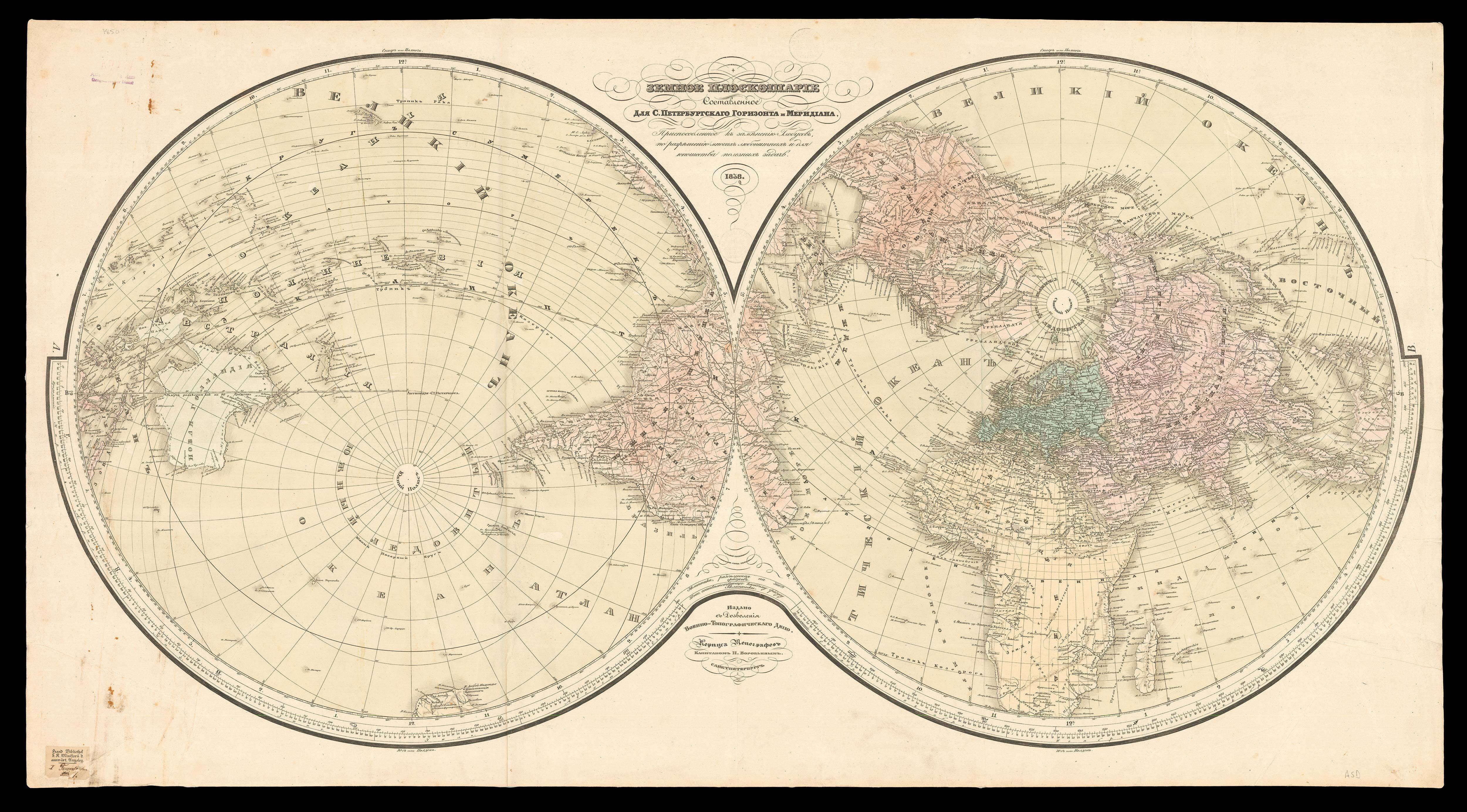
Newton's New & Improved Terrestrial Pocket Globe.
- Author: NEWTON, [John]
- Publication place: London
- Publisher: [Newton & Son] No. 66 Chancery Lane
- Publication date: Jan. 1, 1817.
- Physical description: Globe, 12 hand-coloured engraved paper gores, over a papier mâché and plaster sphere, varnished, brass meridian ring, which sits in an engraved hand-coloured and varnished horizon ring, housed within original shagreen over paste-board clamshell case, with hooks and eyes, lid lined with 12 hand-coloured engraved celestial gores, calotte, varnished. Varnish a little worn in a few places, celestial gores a bit scuffed at edges, case lacking one of the three hooks.
- Dimensions: Diameter: 76mm (3 inches).
- Inventory reference: 15665
Notes
A fine pocket globe showing the latest European discoveries, serving as a memento of the exploration race between British and French sailors.
Biography
During the first half of the nineteenth century the firm of Newton, together with Bardin and Cary, occupied a leading position in the manufacture of globes in London. The firm was established by John Newton in 1783 and operated originally from the Globe & Sun 128 Chancery Lane, moving to 97 Chancery Lane in 1803, before settling at 66 Chancery Lane in 1817.
John Newton (1759-1844) was trained by Thomas Bateman (fl1754-81), who had previously been apprenticed to Nathaniel Hill (fl1746-1768). Newton’s first globe was a revised edition of Hill’s 1754 pocket globe, which he published in 1783 in association with William Palmer. The partnership dissolved shortly after, and Newton continued to publish the pocket globe under his own name. John’s second son William Newton (1786-1861) joined the firm between 1814-1816, which traded under the name J. & W. Newton. In the same year the firm produced a new series of globes, including a new pocket globe.
By the 1830s the firm was also active as a patent agent and was joined by Miles Berry, a civil engineer and patent agent, after which the firm was known as Newton, Berry & Son. In 1842, William’s eldest son, William Edward Newton (1818-1879), joined the business, followed by his brother Alfred Vincent Newton (1821-1900). The firm became known as W. Newton & Son, or once again, on the death of William, as simply Newton & Son from 1861 until about 1883.
Perhaps the greatest triumph for the Newton family was the Great Exhibition of 1851, where, aside from the globes they exhibited from 150 to 635mm (1 to 25 inches) in diameter, they were awarded a prize medal for a manuscript terrestrial globe of six feet in diameter.
Geography
In a departure from pocket globes produced in the eighteenth century, Newton has mounted the present globe in a graduated brass meridian ring. The ring fits into two slots in the paper horizon ring which is pasted on to the lower part of the case. This enables the globe to be positioned at an angle, mimicking the earth’s axial tilt. In Australia, the southeastern coast of the bite is labelled “French disc.”, after the scientific expedition led by Nicolas Baudin (1800-1803). This is a contentious choice on Newton’s part. The British explorer Captain Matthew Flinders was exploring the area at the same time, and the expeditions met each other in the consequently named “Encounter Bay”. Although Flinders completed the task before Baudin, he was captured and imprisoned for six years at Mauritius on his voyage home, along with his charts and manuscripts. This allowed the French explorers to print their account of the new discoveries before Flinders, and for Freycinet to produce the first complete chart of the Australian continent. The maps and charts prepared by Freycinet ignored the discoveries of Grant and Flinders and depict the whole of the newly discovered coast of Melbourne to the border of Western Australia as the “Terre Napoleon”. In North America, the northwest coast is labelled “Vancouver’s disc.”, after George Vancouver’s 1791-95 expedition. Further north, Alaska is marked “Russian Settlements”. The Russian-American Company was formed in 1799, and set up a trading post in Alaska for the purpose of hunting sea otters for their fur. The United States would later acquire Alaska from the Russian Empire in 1867. To the west of Alaska the Bering Straits are shown but not named. To the southern Pacific is “An Improved Analemma shewing the sun’s declination & place in the zodiac for each day of inspection”. In the South Pacific Ocean additional information is provided – “NB. This improved Analemma is intended to supercede the necessity of the Ecliptic Line hitherto unnecessarily drawn upon the Terrestrial Globe” – although Newton has failed to remove the line of the ecliptic that still surrounds the globe.
Astronomy
Only the upper hemisphere is printed to the inside lining of the case with designs depicting astronomical phenomena. To the rim is a zodiacal scale, with symbols of the signs of the zodiac. The rest of the hemisphere depicts the solar system, with the new planet Uranus named after its discoverer William Herschel, who had found the planet on 13th March, 1781. It was the first new planet to be discovered since antiquity.
Bibliography
- van der Krogt New 1
 Rare Maps
Rare Maps  Rare Atlases
Rare Atlases  Rare Books
Rare Books  Rare Prints
Rare Prints  Globes and Planetaria
Globes and Planetaria 










